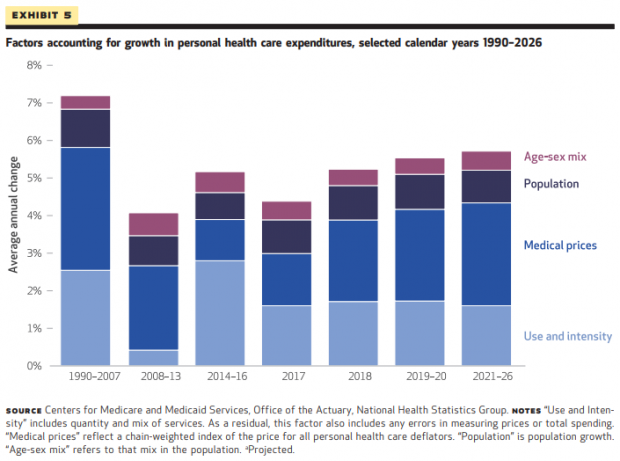Health care spending in the U.S. is expected to grow at an average annual rate of 5.5 percent from 2017 through 2026, faster than the rate of GDP growth. As a result, health care spending will represent 19.7 percent of the economy by 2026, up from 17.9 percent in 2016.The estimates come from a new report by the Office of the Actuary at the Centers for Medicare and Medicaid Services, published Wednesday in Health Affairs.
Analyzing the underlying causes of the growth in spending, the study found that the increase will be driven by “fundamental economic and demographic factors.”
Three components stand out:
1. Medical prices: The rate of price increases for medical goods and services hit historic lows from 2014-2016, but will rebound over the next decade. Prescription drugs will be one of the leading contributors: “Among the largest health care goods and services, prescription drugs are projected to experience the fastest average annual spending growth in 2017–26 (6.3 percent per year). This trend primarily reflects faster anticipated growth in drug prices, which is attributable to a larger share of drug spending being accounted for by specialty drugs over the coming decade.”
2. An aging population: An older population means more demand for health care, more people shifting from private health insurance to Medicare and increased demand on Medicaid to care for the disabled. “Spending growth in Medicare and Medicaid is a substantial contributor to the faster projected overall growth in national health spending through 2026.”
3. Out-of-pocket expenses: Employers have been cutting back on benefits and shifting medical costs onto employees, and that trend is expected to continue. The threat of the Obamacare tax on high-cost health plans could accelerate the trend at some companies, resulting “in faster projected growth in out-of-pocket spending.”
The good news is that we have probably seen the worst of it when it comes to medical price inflation: “Despite the faster growth projected over the next decade, overall national health spending growth is not anticipated to reach rates experienced in the period before the last recession (7.3 percent per year for 1990–2007).”
The good news is that we have probably seen the worst of it when it comes to medical price inflation: “Despite the faster growth projected over the next decade, overall national health spending growth is not anticipated to reach rates experienced in the period before the last recession (7.3 percent per year for 1990–2007).”





